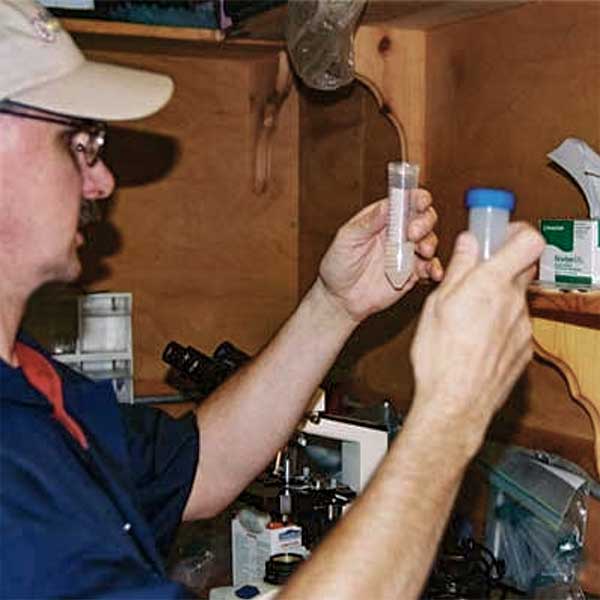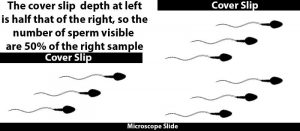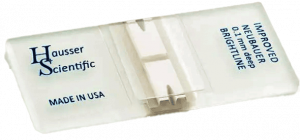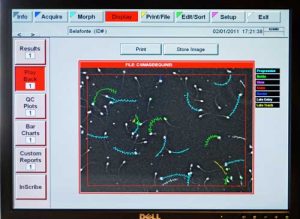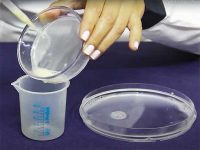Processing Equine Semen
It’s not difficult to correctly process equine (horse) semen for on-farm insemination or shipping, but it is one about which we often receive questions. Here we look at the basic steps behind achieving a good shipment. This article reviews management of a straightforward stallion. Poor quality semen or that with specific issues – although briefly referenced – may require additional management, although the same basics will apply.
So I’ve successfully collected the semen – now what do I do with it?
Clearly that will depend somewhat upon what the end use is going to be for the semen – on-farm insemination; used later on-farm; or cooled-shipped. So let’s look at each in turn, but first let’s consider the immediate handling and initial evaluation of the semen which will apply with all uses.
Initial Handling
Equine sperm is known to be sensitive to a variety of things – temperature changes, multiple substances toxic to it – including plain water, and even the seminal plasma that comes along with the sperm to mention just a few! The obvious initial caveat therefore is to avoid items known to cause problems. The most common of these is going to be temperature change. Use of a protective hood for the collection bottle in cold weather is recommended, and the lab environment where the semen is to be processed should be in excess of 70°F (21°C) – and for the purposes of this article, we are going to presume this to be the case. If the lab is significantly cooler, then different – and more rapid – handling will be required to prevent sperm cold shock, using the incubator throughout.
With a suitably heated lab, upon entering the semen should be filtered if an in-line filter was not used to remove gel fraction and larger dirt or smegma fragments which may have been inadvertently collected (the in-line method being preferable). With horses that have a high volume of gel fraction, double in-line filtering may be helpful. Once filtered a small amount of raw semen can be removed for evaluation purposes (if raw semen is required), and the rest of the semen extended 1:1 (semen portion to extender) with a suitable semen extender. If the stallion is a high-volume producer known to have standard to good sperm concentration, one may be able to remove a smaller portion of the ejaculate for use and extend that 1:1, thereby saving on the amount of extender which would later be thrown away.
Initial Extension
It should be noted that not all extenders will work for all stallions, and not all stallions have sperm that survives in all extenders. It is therefore important to determine which extender is suitable prior to use. This should be done at the beginning of every breeding season, as the best for that stallion may change. This evaluation is performed in a variety of different extenders, reviewing for best progressive motility and longevity (for more details see our article on pre-season extender evaluations). Facilities which operate on the thought process that “we always use the [insert name] extender because it’s the best” or “because it’s always worked for us” should be avoided. There is no extender which will work best for all stallions!
Once extended 1:1, the semen and remaining unused extender can be left on the counter as long as the room temperature is above the minimum discussed above. It should not be placed back into the incubator. Although repeatedly putting into and taking it out of the incubator while processing will be unlikely to damage the sperm (presuming suitable temperatures), the fluctuating temperatures will more rapidly deplete sperm energy levels and can result in reduced longevity. Best results will be achieved if there is a continuous downward gradient of temperature to the storage low point of around 5°C (41°F), and until warmed as a result of being inseminated.
Evaluating the Semen
Evaluation of the semen is the next step to determine quality and sperm concentration, then calculation of the number of sperm – and therefore the volume of raw semen – required for the insemination dose.
Determining Concentration
One cannot determine a suitable insemination dose without knowing the sperm concentration in the ejaculate. It is important to understand that one cannot “eyeball” concentration under the microscope using a regular slide and cover slip because a change in depth of the sample by just a few microns can affect how dense it will appear. One therefore needs to use a counting device of some sort to determine sperm concentration. There are a variety of commercially- available sperm counting devices which make the counting very easy, however some of those such as the most accurate NucleoCounter are very expensive! Even the cheaper photometric devices will be in the range of US$1,000 to US$1,500 which may be outside the financial investment level of the individual just starting. Notwithstanding this, it is still essential that sperm concentration be determined.
Fortunately, there is a cheaper – although more tedious – solution in the form of a hemocytometer, which is specially-designed microscope slide that holds a very accurate volume of semen within its viewable area, and that coupled with a grid of a specific size allows an accurate count of the number of sperm present within the fixed volume chamber of the slide. When first starting out, it will typically take the neophyte around 15 minutes to get a count using a hemocytometer, but that time can be reduced to under 10 minutes when experienced. We discuss the methodology behind counting sperm using a hemocytometer in another article on the website.
It is worth bearing in mind that the photometric counting devices have the potential to be prone to error owing to foreign matter in the semen or a greater or lesser opacity of the seminal plasma itself. These devices work by determining how much light passes through the liquid sample, so obviously dirt would cause the device to think the sperm concentration to be greater than it actually is, while air bubbles might cause it to think it to be lesser. In our experience any of the photometric counting devices may be in error up to 20% at any time – there is no variation between devices with any one being better than another. It should be noted that reuse of cuvettes may also impact accuracy. To counteract any possible inaccuracy, one can simply make an adjustment to the number of sperm intended for use. For example, with cooled semen shipments – which have the most potential to be negatively impacted by erroneous sperm counts – we will often target a final concentration of 35 million sperm/ml which allows deviation in either direction while still remaining within the standard recommended concentration limits of between 25-50 million sperm/ml.
Evaluating Sperm Motility
The next evaluation to be performed is that of sperm motility. We are most interested in the percentage of progressively motile sperm in the ejaculate, as those are the sperm likely to achieve fertilization. Again, tools for determining motility will vary tremendously in price, from the expensive – but very accurate – CASA (computer-assisted semen analyzer) units such as the HRI-CEROS unit such as we use, to the fairly-recently introduced iSperm. The price range for these items will be between about US$40,000 and US$3,000 respectively! Again, fortunately, there is a cheaper – although less accurate – alternative with “eyeballing” the sample through the microscope. For this latter method, one is going to require a microscope that offers 100x to 200x magnification. While a phase-contrast microscope is desirable, a regular bright-light microscope will be adequate. If finances are limited, we recommend seeking a used quality microscope in good condition rather than purchasing a new microscope of lesser quality. When evaluating sperm motility, be tough – particularly when it comes to progressive motility! Even with experienced evaluators, it has been shown that while total motility estimates may be accurate when compared to CASA, progressive motility tends to be over-estimated. Remember that most stallions’ sperm will fall into the 40-50 percentile range of progressive motility. When we see reports of “my stallion has 80% progressive motility” we tend to roll our eyes! Unless the semen has been run through a purifying centrifugation gradient, such rates are not seen (it should be noted that incorrectly set CASA units may return such readings, but if correct standards are set, such high levels will not be reported). A horse with progressive motility in the 60-percentile range is excellent. Remember however, that progressive motility is only a part of the equation! More focus should be applied to the total number of progressively motile sperm in the insemination dose than the level of progressive motility (see our article on insemination dose quality for more details).
So how to “eyeball” motility? Extend the semen to a point where one is seeing perhaps only 20-40 sperm in a microscope view (this number can be increased when one’s experience has also increased, but when starting keep the numbers low). Then simply look at the sample and say to yourself “Are all moving? No… Are three-quarters moving? Yes. Are those all moving in more-or-less a straight line? No. Are half of the sperm moving going in more-or-less a straight line? Yes.” – in which case one would have 75% total motility and 50% progressive motility. Obviously, there are variants of that, but this is the basic concept. Again, we reiterate – be tough in your evaluations! You are better off sending more progressively motile sperm than fewer! (See our article on sperm motility for more details).
A Quick Review of Sperm Morphology
Morphology is the microscopic evaluation of the sperm structural health. While it may be summarily reviewed by experienced evaluators of semen during the normal processing of equine semen, that is not a true evaluation. It’s more a matter of the evaluator noticing the absence or presence of a greater than normal number of morphological abnormalities. This article is not intended to discuss morphological abnormalities, so we will limit our observations to saying that a periodic stained evaluation is worthwhile if there is a question about pregnancy rates or an apparently high number of abnormal sperm are noticed in an ejaculate. Depending upon the levels and type of abnormality, the number of sperm to be included in an insemination dose may be adjusted to counteract damaged sperm which may not be able to achieve fertilization. For the purposes of the rest of the article, we will presume morphological normality with the calculations.
Final Semen Extension Calculations
Here’s where there will be a significant difference in process and calculations depending upon final usage.
Processing Equine Semen for On-Farm Use
For immediate on-farm insemination, one wants a dose consisting of between 100 and 500 million progressively motile and morphologically normal sperm. As noted, we are presuming all morphology to be normal, so we will not discuss that aspect further in the calculation processes. To determine the on-farm insemination dose described, one multiplies the percentage of progressively motile sperm by the sperm concentration in millions/ml to determine the number of progressively motile sperm/ml. Once that has been determined, the desired number in the dose (100-500 million PMS) is divided by the number per ml to determine the volume of raw semen required:
Progressive motility: 55%
Sperm concentration: 220 million/ml
PMS/ml: 121 million
Desired insemination dose: 500 million PMS
Required volume raw semen: 500/121 = 4.13 ml
In the above example, one would quite probably round up the volume of raw semen to 5-ml (always round UP not down – more sperm are better than fewer within reason!) Remember however that the remaining semen has already been extended 1:1 with semen extender, so the actual concentration of that extended semen is half that of the raw semen concentration, so one would double the volume required to 10 ml (if rounding up).
Stallion sperm survive for different durations, it being stallion-dependent. If the semen is not to be used very soon after it has been processed, with some stallions one may simply extend it as above for use on-farm and use it hours later with no loss in fertility value. For other stallions such a practice may reduce pregnancy rates, and the semen should be extended as though for cooled-shipped use if being stored for multiple hours prior to usage. Similarly, some may require cooling, while with others it may be left on the counter. There is no “hard and fast rule” for this, so experimentation for the individual stallion will be required – although immediate insemination is always preferable!
Processing Equine Semen for Cooled-Shipped Use
Remembering the potential for a toxic effect of seminal plasma on sperm which is very much stallion-dependent, for cooled semen being shipped it is necessary to dilute greater than the 1:1 ratio used for on-farm inseminations. The addition of extra semen extender not only dilutes the seminal plasma further but also adds additional beneficial buffers and nutrients to the final volume.
With most extenders, the best results for non-centrifuged semen will be seen when the final extended sperm concentration is between 25-50 million sperm/ml and the dilution ratio is 1:3 semen:extender or greater – and in fact 1:4 or greater is generally recommended. There are some extenders which may work at lower dilution ratios, but typically even they will work better at 1:4 or greater. It should be noted that while the dilution ratio is important, the actual number doesn’t matter as long as the other parameters mentioned are followed – i.e. minimal dilution ratio and final sperm concentration. In other words, if the math calls for a dilution ratio of 1:10 because the raw sperm concentration was 385 million/ml, that is fine! Don’t be alarmed at the math indicating such a high dilution ratio – and reducing it “just because” if you’re worried will probably result in a worse shipment outcome!
It is critical to understand the interplay between final concentration and dilution ratio. Both of those desired levels must be achieved for optimal (best) results! Again, avoid facilities who recommend “We always dilute at 1 to [pick a number]”! A raw semen sample diluted at 1:4 when the raw sperm concentration was 500 million/ml will likely produce a very different result from one that was 100 million/ml (final concentrations respectively being 100 million/ml and 20 million/ml) diluted at the same ratio.
Insemination volume should not exceed 60 ml per dose. A volume greater than that may result in loss back through the cervix, particularly in maiden mares. High volumes do not usually appear as a problem unless one starts with very low raw sperm concentration. As a general rule, if the raw concentration is lower than 100 million sperm/ml, increasing sperm concentration is going to be required to obtain good results. This can be achieved by centrifugation, use of the BotuPharma sperm filter, or during the collection process in “known offenders” by fractionating the ejaculate, capturing only the first three ejaculatory spurts.
The number of sperm to be shipped will depend greatly upon personal choice and the number available. At Equine-Reproduction.com, LLC we like to ship a minimum of 1 billion progressively motile sperm at the time of shipment, which allows for a possible 50% die-off rate during shipping to provide an insemination dose of 500 million progressively motile sperm. Others may ship 1 billion sperm total, which may end up with an insemination dose lower than the 500 million progressively motile upper threshold. If the stallion is heavily booked and multiple doses are required on a single day, or he is a low sperm-number producer, then the lesser method may be necessary. Similarly, shipping two insemination doses may be possible, but personal preference and sperm availability will play a part in the decision. If the timing of the insemination relative to ovulation is good, then a second dose is superfluous, however if there is a delay in the ovulation occurring, it may make the difference between pregnant or not.
The “500 Million” Myth
We should include a comment about the “500 million progressively motile sperm ‘insemination dose'” concept. That number came from research published in 1998 which was looking at the upper end number beyond which pregnancy rates did not increase1. Unfortunately, many in the industry took that to mean that 500 million was a required number of sperm to achieve good pregnancy rates, which was not the case. It was not for another 8 years that research by Brinsko determined that the minimal number below which pregnancy rates started to suffer was actually one-fifth of that upper number, standing at 100 million progressively motile sperm, but the damage had been done, and almost 30 years later, we still hear people referencing 500 million PMMNS as being “the dose”!2
Additional Processing
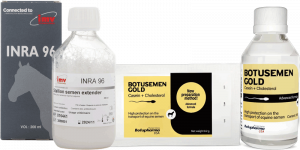
There are many extenders commercially available, with INRA ’96 and BotuSemen extenders being among the most commonly used.
The above are the parameters most commonly seen in North America. In other parts of the world – notably Europe – it is common to see semen being routinely centrifuged prior to shipment. While this practice may improve some stallion’s sperm longevity dramatically (usually those with particularly toxic seminal plasma), in many cases it is not really necessary. It is a little ironic that while centrifugation may increase longevity, the distances travelled in Europe are considerably shorter than those in North America, and yet centrifugation is not commonly used in the latter region! One thing that will be impacted by centrifugation is the final volume of the shipment, which will usually be lower than with non-centrifuged semen. With some extenders – notably the widely used BotuPharma “Gold” or “Special” extenders – because of cholesterol content, it is necessary to ship the sperm at a final concentration in excess of 100 million sperm/ml if those extenders were used for centrifugation as well. Some facilities – again more commonly in Europe – are shipping super-concentrated shipments containing only 800 million sperm total in a 4-ml volume. These typically make use of deep-horn insemination techniques, which in Europe limits their use to veterinarians. (See our article on semen centrifugation for more details on the process).
The Math Behind Processing Equine Semen!
Let’s look at the math associated with cooled semen shipments, for which we will presume we are shipping 1 billion total sperm:
Divide 1,000 million (1 billion) by the sperm concentration in millions/ml
Result is the number of ml’s of raw semen required – round up to the nearest whole number
Divide the actual raw concentration by the desired final concentration
Result is the “dilution factor” – subtract 1 to obtain the “dilution ratio”. i.e. Factor = “5”; ratio = 1:4
Multiply raw semen volume by dilution factor
Result is the final shipping volume, which should be below 60 ml.
Divide the actual number of sperm shipped (if raw volume is rounded up) by actual volume to confirm final concentration is within desired parameters.
The above calculation method can be adjusted to fit the desired number of sperm being shipped. If one wishes to ship 1 billion progressively motile sperm, then instead of the first line of the above calculation being performed, one has to substitute the calculation used to determine the on-farm insemination dose provided above, changing the “500” used for on-farm to “1,000”. The rest of the cooled calculation still applies, as dilution ratios and final concentrations apply to the total sperm number, not the number of progressively motile sperm in the shipment.
For those of you sitting there rolling your eyes, fear not! The panicked look on your face is not unknown to us during lectures on this subject, and so we created our semen extender calculator. Go and plug in your numbers and play! There is also an educational component to the calculator which will tell you if you are attempting to create a dose which is not practical with that particular set of raw semen parameters.
Packaging
 Once the semen has been suitably extended, it will be transferred to an appropriate container. This may be syringes, centrifuge tubes, or the BotuAI bottle. In most cases best results will be obtained if there is no air in the container with the semen, however this is also method and extender dependent as some extenders allow aerobic shipping with no negative effect. Once within the fluid container, the semen will be put into the outer protective shipping packaging. The Equitainer is the “gold standard” packaging for this, providing best longevity of cooling as well as being a reusable container thereby saving discarding it into a landfill such as happens with the “disposable” containers. None of the disposable containers which have gained almost universal popularity reliably provide the 72-hour cooling duration of the Equitainer – most being able to maintain cooled interior temperatures for 24-36 hours at most, and that being highly dependent upon ambient temperatures – however the cost of purchase is usually passed on to the mare owner, which does not occur with the Equitainer. Actual shipping (courier) costs interestingly are not that different between the two forms of container when the purchase price of the disposable container is added into the calculation. Regardless of the container being used, it is important that the associated coolant cans or packs have been frozen in a good quality freezer for at least 24 hours prior to usage. Failure to use adequately frozen devices will clearly compromise duration of interior cooling.
Once the semen has been suitably extended, it will be transferred to an appropriate container. This may be syringes, centrifuge tubes, or the BotuAI bottle. In most cases best results will be obtained if there is no air in the container with the semen, however this is also method and extender dependent as some extenders allow aerobic shipping with no negative effect. Once within the fluid container, the semen will be put into the outer protective shipping packaging. The Equitainer is the “gold standard” packaging for this, providing best longevity of cooling as well as being a reusable container thereby saving discarding it into a landfill such as happens with the “disposable” containers. None of the disposable containers which have gained almost universal popularity reliably provide the 72-hour cooling duration of the Equitainer – most being able to maintain cooled interior temperatures for 24-36 hours at most, and that being highly dependent upon ambient temperatures – however the cost of purchase is usually passed on to the mare owner, which does not occur with the Equitainer. Actual shipping (courier) costs interestingly are not that different between the two forms of container when the purchase price of the disposable container is added into the calculation. Regardless of the container being used, it is important that the associated coolant cans or packs have been frozen in a good quality freezer for at least 24 hours prior to usage. Failure to use adequately frozen devices will clearly compromise duration of interior cooling.
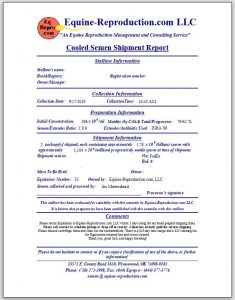
The information sheet we send (filled out) with every semen shipment from Equine-Reproduction.com, LLC. Something similar should accompany all shipments!
The final – and possibly one of the most important – steps prior to actually closing the container and sending it off with the courier are to identify the stallion whose semen it is and include other pertinent information for the receiving facility!! This is a step often overlooked and is a defining indication of professionalism! Write the stallion’s name and the date of collection on the outer surface of the container – be it the container that actually holds the semen (syringe/centrifuge tube/BotuAI) or the outside of the shipping container – and preferably both!! In particular at busy insemination stations, multiple semen shipments are received each day, and it is a continual source of frustration when shipments arrive with no identifying features. There ensues a period of “What stallion is this? What mare is it for?” questioning and subsequent trepidation lest an error should be made!
If using a courier company such as FedEx or UPS, it is useful to include the destination’s and/or mare owner’s e-mail address for notifications when creating the waybill. This will allow them to receive updates to follow the shipment and determine if there is a possible delay. We recommend insuring the shipment for the value of replacement – the collection cost – in case there is a delay. Note that you will not be able to claim for associated costs such as veterinary bills, but you can claim “replacement cost” – i.e. the charge for collection – and shipment charges as long as the delay is not weather-related. It may require persistence in achieving success with the claim – and note that in our experience we have had more success with claims with FedEx than with UPS (who – UPS – actually have never paid out on a claim we have made for delayed delivery).
Summary
Processing equine semen for on-farm insemination or shipping is not particularly difficult to do well, but some knowledge, equipment and attention to detail are essential. If more information or training is required, please note that we do offer both short courses and individual one-on-one tuition to assist with your success.
References:
1: Squires EL, Brubaker JK, McCue PM, Pickett BW. 1998. Effect of sperm number and frequency of insemination on fertility of mares inseminated with cooled semen. Theriogenology 49;4:743-749.
2: Brinsko S.; (2006) Insemination doses: How low can we go? Theriogenology 66:3 543:550 (Proc. Annual Conference of the Society for Theriogenology).
© 2025 Equine-Reproduction.com, LLC
Use of article permitted only upon receipt of required permission and with necessary accreditation.
Please contact us for further details of article use requirements.
Other conditions may apply.

